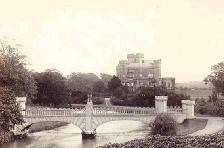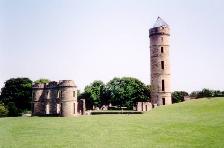
Clan Montgomery The Montgomery’s are thought to have originated from a Norman family that held the Castle of Sainte Foy de Montgomery at Lisieux. The first Montgomery who appears on record in Scotland is Robert who obtained the lands of Eaglesham in Renfrewshire (south of Glasgow). John de Montgomery and his brother, like most other clans of that time, are listed on the Ragman Roll rendering homage to Edward I of England for their estates in 1296. It is more than likely they fought alongside Robert the Bruce as the War of Independence escalated. Sir John Montogomery, 7th Baron of Eaglesham, was one of the heroes of the Battle of Otterburn 1388 capturing Sir Henry Percy. The Percys paid a large ransom for the release of Sir Henry, this helping fund the building of Polnoon Castle for the Montgomery’s. Sir John Montgomery married the heiress of Sir Hugh Eglinton with which he acquired the Barony of Eglinton and Ardrossan north of Irvine/Ayrshire. Alexander Montgomery was a member of the king’s
council who was sent on several important missions to England. He was
awarded the title Lord Montgomery in 1449. |
| Hugh, 3rd Lord Montgomery, supported Prince James in rebellion against his father James 111. He fought at the Battle of Sauchieburn in 1488 that saw the death of James 111 and his son become king. Lord Montgomery was rewarded for his loyalty with a grant for life of the Island of Arran and the keepership of Brodick Castle. The following year he was made Baillie of Bute and Cunningham, this being the start of the Montgomery/Cunningham feuds as the Cunningham’s took exception at loosing the Baillie of Cunningham. Lord Montgomery then began building Skelmorlie Castle north of Largs/Ayrshire on lands received from the Cunningham’s. |  |
In either 1507 or 1508, Lord Montgomery was created Earl of Eglinton. He survived the battle of Flodden September 1513 against the forces of Henry V111 of England that saw so many other Scottish Nobles and King James 1V himself slain. Hugh, the 3rd Earl, a devout Catholic, supported Mary Queen of Scots against the protestant reformation. He fought for her at the Battle of Langside where he was taken prisoner. Hugh was eventually released in 1571. 1586, the 4th Earl became a victim of the Cunninghams of Glencairn. The earl was riding from Eglinton to Stirling when he was attacked by John Cunningham, brother of the Earl of Glencairn and his men. The 4th Earl was shot dead in the attack, probably by John Cunningham of Colbeith. The original Eglinton Castle was set on fire by the Cunningham’s around that time. The Montgomery’s responded to the murder and burning of the castle by killing every Cunningham that came in their path. John Cunningham of Colbeith was eventually tracked down and cut to pieces on the spot. The 6th Earl of Eglinton was captured by the
Parliamentarians at Dumbarton during the Civil War. He remained imprisoned
in Berwick until the restoration of the Stuart’s to the throne in
1660. |
1796, the magnificent new castle of Eglinton was built. 1839, the 13th Earl of Eglinton organised
the celebrated tournament at Eglinton Castle, which set out to recapture
the spectacle of medieval jousting. The lands of Eglinton also became
the setting for the annual Eglinton Hunt frequented by the Scottish hierarchy. |
 |
1700s - 1800s, prominent Mongomery’s move to North America where they achieved high military status. They were followed by many of the Montgomery Clan that took place in the many wars in America and Canada. The present chief is the 18th Earl of Eglinton
and 9th Earl of Winton. |
| Eglinton Castle was abandoned by the Montgomery’s in 1929 after they lost their money building Ardrossan Harbour. The castle soon fell into disrepair, which led to it being used for target practice for tanks during World War Two. |  |
| Skelmorlie Castle has remained in excellent condition. The present owner of Skelmorlie and Eglinton Castles, Jim Wilson, offers apartments in Skelmorlie Castle for holidays. |